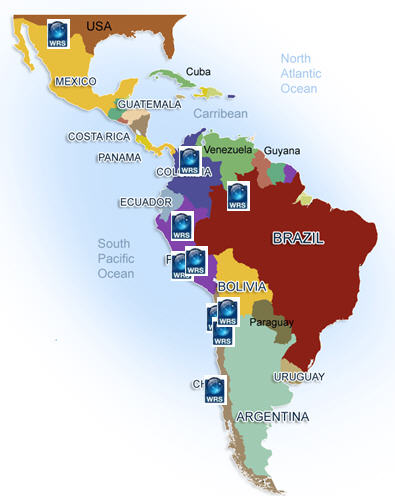Focus on Latin American mining industry
Despite a softening in the global mining sector, Latin America continues to grow as a destination for mining investment, exploration and development on the back of its highly prospective geology, reduced cost profile and attractive mining environment1.
With the ongoing challenges within the global Mining industry, Lucy Donald of WRS, a specialist in sourcing talent for this sector, gives an overview of this region, synonymous with the quest for El Dorado, the golden city. Although the “golden one” is actually not a place but a person – as recent archaeological research confirms!
The region of Latin America covers one-sixth of the Earth and produces more than its share of the world’s three most important metals – iron ore, copper and, of course, the ubiquitous gold. With its huge iron-ore mines, Brazil dominates the region’s mining, whilst Chile, because of its important copper mines, was the second most significant producer of mined metals in Latin America during 2013.
Although mining activity across the region, like much of the world, has been falling since early 2012, there are signs of improvement, with the search for gold continuing to dominate the drilling reports throughout 2012-2013, with the highest level of exploration effort focused on the Pacific rim.
From the Victorian era to the present day, mining has resulted in some great feats of engineering, which has helped the development of infrastructure and economies for many countries, for example, the building of railways through the Andes. Even with this development, the region does continue to have some considerable challenges, which range from socio-environmental issues, electricity supply, water supply, inadequate transport infrastructures, conflicts with the communities and local political problems.
These challenges are also compounded by significant cultural differences between all the Latin American countries, even among those that, from a distance, seem most similar, such as Argentina, Chile and Uruguay. Another key factor in recruitment is that popular attitudes to the mining industry and its legacy vary enormously from country to country. However, despite all these factors, in 2013 the region produced 45% of global copper production, 50% silver, 26% molybdenum, 21% zinc and 20% gold.
The quest for gold cannot be ignored as Latin America has been a major beneficiary of the 2000s gold bull, partly due to some big discoveries by the mining companies that set up operations there. Some of these discoveries have already been developed, with top-three producers by country being Peru, Brazil, and Chile, seeing their collective gold output increase by 25% since 2001. Some projects are still in the pipeline, with production on the horizon and these projects come in all sizes and are scattered right across the region, although there are many located within the borders of the three countries mentioned above. But there are others elsewhere, from Argentina and Colombia to little known Guyana.
A total of US$8.9 billion has been raised since end of August 20111 for the development of mines in Latin America and four countries – Mexico, Panama, Brazil and Peru – accounted for 85% of this total, with most being spent on the development of operations focused on copper and the ever present gold as you would expect.
Paloma Ortiz-Lopez, a specialist in recruiting for clients throughout Latin America for WRS, says, “Our main requirements are Managerial Maintenance positions and the current focus within the region for recruitment is, in order of popularity, Chile, Peru, Mexico, Colombia and then Brazil.
Here are some key facts on a couple of the top Mining countries within Latin America:
Peru
US$56 billion of mining investment is expected to go into Peru by 2020, which is the 2nd largest producer of both copper and silver, the sixth largest global producer of gold and 3rd largest recipient of foreign investment in mining projects throughout Latin America. 94% of mining investments go into Copper, Gold, Iron and Zinc. The country also has significant reserves of iron ore, tin, sulphur and zinc. Mineral exports account for about 60%of Peru’s total shipments abroad.
According to a report form KPMG, labour is abundant and trainable in Peru, although there are shortages of highly skilled workers in some fields. In 2011, the mining sector had about 120,000 employees. The National Society of Mining, Petroleum and Energy (SNMPE) estimates that an additional 40,000 employees will be required to complete the mining projects and investment plans currently in progress. In order to fill that gap, the sector is planning to open Focus some employment opportunities to foreign professionals and technicians. However, Peruvian law currently stipulates that no more than 20 percent of a company’s workforce can be non-Peruvian.
Chile
Chile has abundant metals and minerals, especially in its northern desert region. None of these is more important than copper, for which Chile is widely known as the world’s number one producer. One third of all copper reserves in the world are in Chile and reserves of fine copper are estimated to be in excess of 100 million tons. The presence of Copper has made mining a key sector of Chile’s economy, although the country is also the world’s second largest producer of gold and contributes over half the global production of lithium too.
Nearly 90 percent of Chile’s trade is conducted within free trade. Chile currently has more than US$60B of infrastructure projects in its pipeline, including transportation and power transmission. With its strong set of attributes, the EIU expects Chile to attract US$28B of foreign direct investment by 2017. The country’s mining and environmental regulations are well defined, and the government is working in the direction of sustainable development. The tax regime is currently stable, but the Chilean government is under pressure to increase company tax rates.
According to EIU forecasts, up to 2016, Chile will retain its position as the most attractive business destination in the Latin American region.
There are some changes in the law in terms of employees’ rights and benefits, which has had an impact on the recruitment market within Chile. Additionally they have really high energy costs as well as issues with the water – both of which means that workforce overheads have to be optimised and managed very carefully.
The industry opinion
While there is much to be positive about when it comes to mining within Latin America – what is the view of the mining companies themselves? BNamericas Mining Readers Survey 2013 showed that 44.4% of mining company respondents saw Chile as the South American country with the best mining investment climate. Chile was followed, in order, by Peru (22.2%), Brazil (14.8%) and Colombia (7.4%). Move forward 12 months to 2014 and there is some change. The countries with the most improving climate saw Peru overtake Colombia as the nation where the most respondents believe the investment climate will improve. Chile remained ‘the best,’ but definitely more fragile than previous years.
What next then for Mining in Latin America?
One of the most significant challenges will continue to be infrastructure and the need for significant development over the next few years. Willis, a leading global risk advisory organisation, reports that Latin America will have to invest about 9% of its GDP in infrastructure every year from now until 2020 inclusive in order to eliminate the gap between it and South-East Asia.
What are your thoughts on Mining within this mineral and metals rich region? Email, tweet or join us on Linked In and let us have your comments so we can build a 360 picture of this diverse region.
1 Latin America 2013 Annual Report
{{ commodity.name }}
{{ post.title }}
{{ post.date }}





Comments